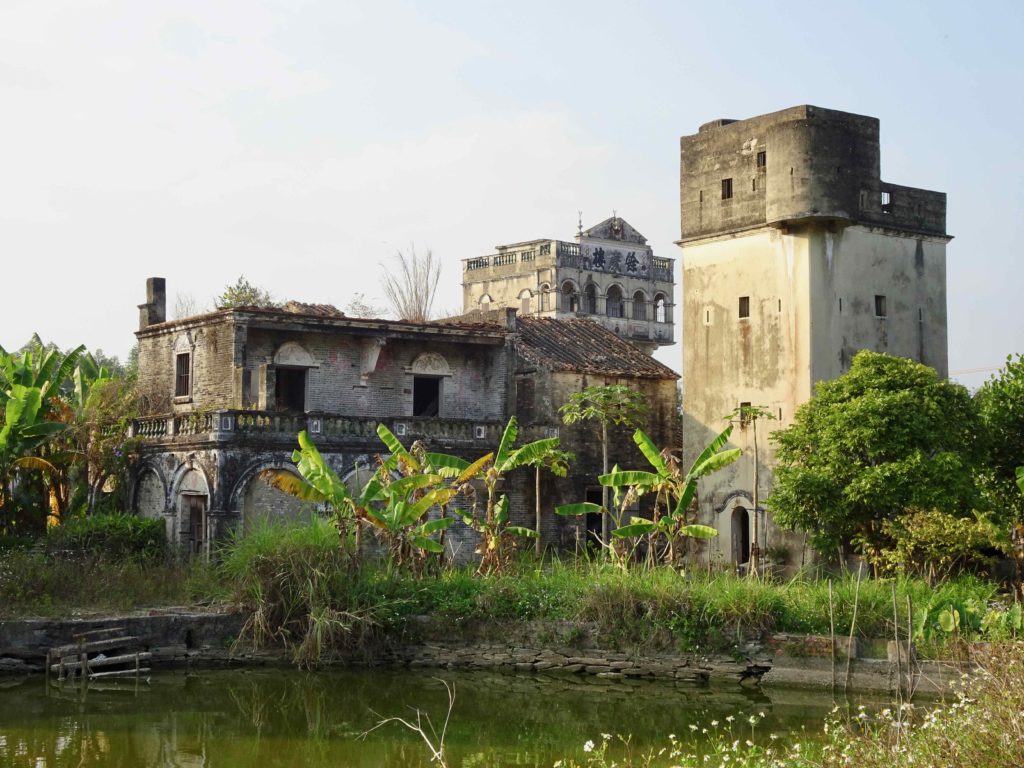If you follow my blog, you know that I like historical ruins a lot, much more than unfinished and abandoned buildings. I also love finding buildings with an interesting architecture, especially the ones combining Chinese and Western architectural styles, such as Republican-era buildings in Beijing and Shanghai. But there are other fascinating forms of mixed-style architecture in the southern parts of China. Yesterday, I rode a bicycle with Gui around Kaiping city, in Guangdong province, to appreciate from a closer point of view the many « diaolou » in surrounding towns and villages. Dialou is a military term which means watchtower or fort with more than one storey.
A unique combination of Chinese and Western architecture, revealing a special regional tradition

The diaolou were built between the end of the 19th century and the beginning of the 20th by émigré Kaiping inhabitants (who emigrated to North America, Southeast Asia and Australia) in order to protect their home villages during a chaotic time. When they returned home, they held a very high degree of social prestige and their architecture shows the socialization to another culture. The diaolou built by those wealthy families are unequaly distributed around Kaiping county. They also have various structures and forms. Some were made out of stone, others of rammed earth or even of reinforced concrete1. Not only were they a symbol of wealth, they also played an important defensive role in the history of those villages when the region was politically unstable and when the local authorities were unable to guarantee the people’s safety. But nowadays, almost no watchtower is inhabited. Most of them are used as storage space or to raise chickens.

Abandoned diaolou in deserted villages
Some villages have been protected since 2001 as part of the UNESCO World Heritage list. There, the diaolou have become a very valuable asset for the local inhabitants and for the local growth. But other villages are still losing their population. As for the diaolou in those deserted villages, many are in ruins. Here are some pictures I took during this short trip. I could go inside some watchtowers. But most of them were locked. In any case, the most interesting part is their general architecture, and this should be admired from outside, as there is a global harmony between the buildings and their natural environment. There are still many villages to explore, so I might update this report later.

This watchtower has been abandoned for at least 20 years. It is completely overgrown and one must walk in a jungle to find it. But it was possible to go inside.

One can appreciate traces of its delicate decorations on the walls.

There were still a few elements of the past inside.



The houses around it had no roof and doors and windows were just holes.


In another village, there were many abandoned diaolou altogether, next to some farmlands.





Finally, last but not least, there was a beautiful school, but unfortunately, it was quite hard to go inside.


The diaolou buildings display a unique fusion of Western and Chinese historical elements, and their diversity makes a trip to this area worth it, both for landscape lovers and for ruin lovers.
If you like historical ruins with Chinese and Western styles, you can read about Beijing’s most famous haunted house or about Shanghai’s Shamei Mansion.
If you like abandoned villages, you can read my report about abandoned yaodong in Shanxi province.
- See Patricia R.S. Batto, « The Diaolou of Kaiping (1842-1937): buildings for dangerous times », China Perspectives, n°66, 2006. ↩
